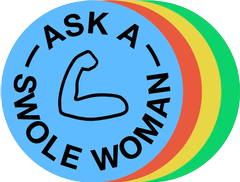I want to know how I will know when it’s time to lift heavier weights! I got started with a program to build strength, but how do I know it’s time to go up, and by how much? Is there a formula for adding weight? Plus 10 percent or whatever? And how do I know the amount of weight I’m lifting is hard enough or heavy enough? --JG
Over the years that I’ve been lifting heavy weights, it has both astonished me how many programs I’ve found that have incomplete instructions, and it has not surprised me at all, because it validates how confused I was for so long about what one is supposed to do when one goes into a weight room.
If you know as little as lifting about I did as when I started, you might look at a program like this:
And think, OK, sick, I have to just, go into a gym, and do these things, and, bing bang boom, “fitness” (?) is gonna Happen to Me!
And then you arrive at the gym, screenshotted list of gym tasks in your phone, and three steps beyond the front desk, you freeze as you take in the jungle of machines, levers, pins, weight stacks, cables, dumbbells, barbells, plates, grips, and attachments, not to mention the teeming sea of variously sweating bodies.
The first task on your list is “Goblet Squat 3x12.” Okay but… how? And then even given a how… how much? You frantically Google “goblet squat” on your phone and come up with a 15-second video of an automaton-like model perfunctorily dipping their body down in a wide stance while holding a dumbbell to their chest.
That answers that, but then there’s still the question of weight. You scrutinize the contours of the dumbbell in the model’s hands, but the number printed on the dumbbell is obscured by shadows. You paw at your phone’s screen fruitlessly, but it can’t zoom in any farther.
Still standing about three steps from the front desk, effectively in the middle of the room, people coming and going edge by you as you replay the video ten more times trying to screenshot the exact moment the embossed poundage number catches the light just so. You rapid-fire screenshots and then pull them up, studying the screen as if you are evaluating the Zapruder film with a photographer’s loupe. In one screenshot, you think you can make out a 35. Or is it 45?
You march over to the dumbbells and literally can’t even move a 35-pound dumbbell from its spot on the dumbbell shelf. Embarrassed, you pick up some 2.5-pound dumbbells and do a few bicep curls to throw any suspicious observers off the scent of your total incompetence. After a plausible-seeming number of reps, you turn on your heel and head toward the door.
It might surprise you, or not, to know that this didn’t just happen to me once before I figured out a way to improve upon the overall circumstances of gymgoing; it happened many times. It’s easy to overlook the basic process details of something you’ve never done before, only to be paralyzed by them when the moment comes. In my case this almost always turned into a fact-finding question for the one true Google-able answer, which brought the whole endeavor to a grinding halt.
But some things are not Google-able, not really; the only true answer is inside of you. And that’s the kind of answer that the question “how much weight you are supposed to lift” has.
Do you want to learn to lift weights? Join the Swole Woman Discord. Have a question about working out, eating, health, or why you shouldn't be afraid of lifting heavy? Send it to [email protected] and follow @swolewoman on Instagram.
Two columns ago, we covered what “progressive overload” is and how much weight you can add, per session, when you are getting started with strength training. We also covered “linear progression,” which is a good approach for new lifters to build strength where they do “progressive overload” by adding a small amount of weight every session (so today you squat ten pounds, the next time you go to the gym you 15 pounds, the next 20 pounds, and so on).
But where you start, and how it should feel, is a little murkier. For a newb, a good zone to shoot for on each set is “RPE 8.” That means, on the rate of perceived exertion scale from 1–10, 1 being “so easy you didn’t feel anything” and 10 being “you did it but now you’re going to die,” 8 is “you did it and feel gassed but not completely, and your form was still good.” It means, if pressed, you could do one or two more reps without sacrificing your form, but not wildly more or less than that.
OK, fair enough, but how do you know what it feels like? The answer is you don’t, and the only way is to find out.
RPE 8, or any RPE, is interesting because it is both a universal and personal thing.
Even when I found a good program, a lot of times the instructions on intensity weren’t any more specific than “whatever feels good or right to you.” I had no idea what felt good or right to me; all I did was diet and run, two concepts that for me were entirely divorced from how I felt. I hadn’t thought much about how anything felt my whole life; stuff just happened and I scraped together my resource crumbs to accommodate it. And then here came strength training, asking me how I “felt.” I don’t know, bitch!
So when I started lifting, I would do one of my five-rep sets and… then what? If it hurt but only sort of, was that “enough”? If it was tiring, but immediately after I stopped I felt better, should I have done more weight? Or was it too hard? I didn’t know, but also, no one could tell me.
If I had to describe RPE 8, it would be something like, “the feeling of having been briefly chased by a bear.” It’s more than just being out of breath; there’s an added layer of having successfully but very tangibly fought for your life. To be clear, this does not even necessarily mean I’m sweating an 8/10 amount, or breathing 8/10 hard, or in 8/10 pain. It’s just “intensity.” You are like “but what does that MEAN.” You will find out! You WILL find out.
What helped me the most in figuring out this feeling more quickly was to experiment and pay attention to what happened. I could try adding way more weight, or instead of doing only my five reps, I could just keep going and see if I could do way more reps than that. If I could, then I knew I was way undershooting whatever “RPE 8” was for me. You don’t want to be all over the map all of the time, but if you’ve suspected for a few weeks that you’re undercutting yourself, this is a way to find out.
It also helped to keep a log of my workouts—not just the weights I lifted but how they felt. Descriptions or rating the feeling out of 10 can be two good ways to go. My lifting notebook is littered with “that felt like shit”s and “wow good!!!”s variously carved into the margins, so you don’t have to be Shakespeare. You think you will remember this stuff in two days when you come back to the gym, but trust me, you won’t. Write it down. You should be resting between your sets anyway, might as well put that time to use inscribing your little diary with the day’s travails, like a de Tocqueville of Lonny’s Black Iron Dungeon and Health Club.
And truthfully, whether a lift is too hard is not something to worry aggressively about when you are linearly progressing. You might even cherish the days when it’s easy-ish, because you are adding weight quickly enough that if a lift isn’t hard enough now, it probably will be in a matter of a couple weeks.
Why RPE 8, and not 9 or 10, or 5 or 6 or 7, or as the Cleveland Clinic bafflingly, specifically recommends, a 3 or 4? (What? No. At least in terms of how we use RPE in strength training, a 3 or 4 would be like a brisk walk; you’re a big dog now, you are allowed to touch the 8s.) But starting out, it helps to dial in just one RPE, and RPE 8 is the sweet spot for “growth without risk of overshooting.”
RPE can seem a little weird to new lifters, because they might only understand progress only as “the weight goes up.” But eventually you outgrow that, in six months to a year, and things get murkier. A lot of more advanced lifters program according to RPE, which means they trend upward, obviously, but aren’t lifting a particular amount of weight session to session or week to week. They’re shooting for a particular right-sized feeling of challenge, and purposefully do RPE 9s and 10s, as well as 5s, 6s, and 7s. I use RPE, and some weeks an RPE 7 set of five squats might be 210 pounds; others it might be 185 pounds. It’s more imprecise than weight numbers, but also more flexible.
Some people don’t like RPE because it involves feelings, and they’d rather fail or go too easy than try to gauge what their body feels like continuously. As Miss Intuitive Strength Journey of the Mind-Body Connection, I like RPE. The purpose of this whole strength endeavor is getting to know myself and how to challenge myself, and maybe even more importantly, how to be compassionate with myself, because I am a consummate hard-ass. And if I’m not tuning with how anything feels, I’ll never really figure that out.
So while you might not use RPE as the center of your program when you’re starting out, it helps with your overall journey (in strength, in life) to start to pay attention to “what things feel like” so you can develop your sense for you, personally, of what’s too much, what’s not enough, and what’s just right.
Disclaimer: This content is for education and entertainment purposes only. Casey Johnston is not a doctor, nutritionist, dietitian, personal trainer, physiotherapist, psychotherapist, doctor, or lawyer; she is simply someone who has done a lot of, and read a lot about, lifting weights. Consult a professional for your personal medical and health needs.
You can read past Ask A Swole Woman columns at The Hairpin and at SELF and follow A Swole Woman on Instagram. Got a question for her? Email [email protected].

